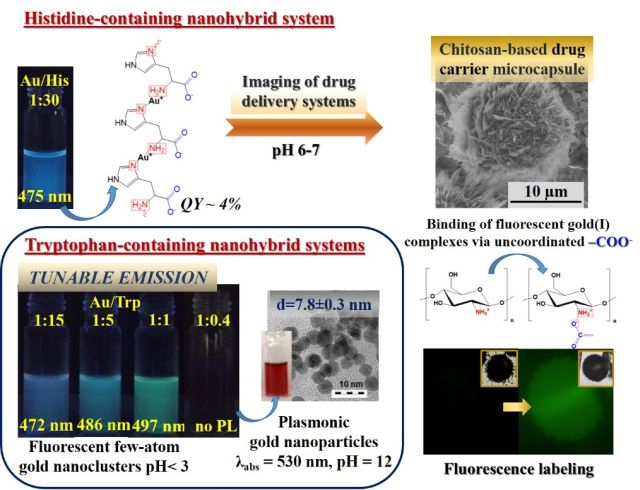MTA-SZTE Biomimetic Systems Research Group
Principal investigator: Gábor Tóth
Gold nanohybrid systems: Syntheses, structural characterization and sensor applications

Due to the unique shape-, size- and composition-dependent optical properties the noble metal nanostructures are widely used materials and they have been extensively investigated in different ways [1]. The development of gold (Au) and silver (Ag) nanoparticles (NPs) - or nanoclusters (NCs) - based optical biosensors and bioimaging agents is one of the most important area in nanomedicine. In recent years, the biocompatible preparation route of nanosized noble metal particles is in focus of extensive research. The ultra-small Au NCs show unique physical and chemical properties such as well-defined molecular structure, discrete electronic transitions and characteristic strong photoluminescence (PL). If the gold NCs consist of only a few-atoms (blue-emitting NCs) the appearance of the emission peak only depends on the number of metal atoms in the clusters. Furthermore, if the size of the NCs reaches the ~ 1.5-2.0 nm (red-emitting NCs) both the oxidation state of the surface metal atoms and the surface ligand effect influences the wavelength of the emission maximum. These NCs having characteristic PL in the orange/red (Vis) or in the near infrared (NIR) region. According to the unique structural and optical features the Au NCs are potential candidates as fluorescence markers, and their sensor applications are in focus of interest. In our research group the biocompatible fabrications of Au NPs and Au NCs using proteins or amino acids have been carried out [2-4].The main goal of our work is to investigate the interactions of AuCl4- and the studied biomolecules as well to optimize the gold/ligand ratios and pH on the formation of gold constructs. Based on the experimental results we provide important information on the formation mechanisms of the nano-objects. Moreover, the fluorescent Au NCs were used for selective detection of different transition metal ions (e.g. Fe3+), anions and small molecules in aqueous solutions.
References:
[1] A. Majzik, L. Fülöp, E. Csapó, F. Bogár, T. Martinek, B. Penke, G. Bíró, I. Dékány: Colloids and Surfaces B: Biointerfaces, 81 (2010) 235.
[2] V. Hornok, E. Csapó, N. Varga, D. Ungor, D. Sebők, G. Laczkó, I. Dékány: Colloid and Polymer Science, 294 (1) (2016) 49.
[3] E. Csapó, D. Ungor, Á. Juhász, G.K. Tóth, I. Dékány: Coll. Surf. A, 511 (2016) 264.
[4] D. Ungor, E. Csapó, B. Kismárton, Á. Juhász, I. Dékány: Coll. Surf. B. 155 (2017) 135.

